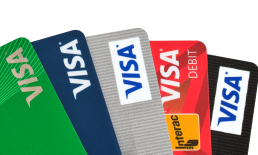Today if one says the word eBay anywhere in the U.S. — and in multiple spots around the world — you will be hard-pressed to find someone who doesn’t instantly know as to what you are referring. They may never have made a purchase on the online marketplace, but the odds are good they know at least one good story about something bought it on eBay story. Old gum, entire towns, Justin Timberlake’s half-eaten French toast and a cornflake in the shape of Illinois are just a short list of some of the weirder things that have been bought and sold on eBay over the years.
However, coming out of Labor Day weekend 24 years ago — eBay was far from a household name, for two main reasons. The first is that it was only about a day old. EBay V.1 went live over Labor Day weekend 1995 from founder Pierre Omidyar’s San Jose, California, living room. The second was that at the time it technically wasn’t called eBay — it was called AuctionWeb. EBay Internet was the name of Omidyar’s umbrella company that was the parent to four sites. The first was AuctionWeb. The other three included a travel site set up in loose partnership with a local San Jose travel agent, a personal shopper site and a site about the Ebola virus.
Of the four, AuctionWeb was the only one that really caught on with customers and was more often referred to as eBay than by its actual name by both customers and in media coverage. Also, AuctionWeb famously has one of the worst logos in early internet history. It was black and white, boxy and found so menacing looking by eBay’s first employees that it was internally referred to as “the Death Bar.” Steve Westly, one of eBay’s founding executives, persuaded the company to redesign it in 1997 on the argument that it was so bad it was scaring away potential corporate partners and investors.
They eventually settled on the multicolored eBay logo that we all recognize today — albeit in a slightly different (far less 1990s) font.
The Early Days
If Amazon was first known as the internet’s bookstore — eBay quickly became known as the internet’s garage sale — the digital portal that one could buy anything and everything. Some of it was junk. The first thing ever sold on eBay was a broken laser pointer purchased by Canadian Mark Fraser in 1995.
Advertisement: Scroll to Continue
EBay’s founding goal, as stated by Omidyar, “bringing together buyers and sellers in an honest and open marketplace,” but creating that a was a challenge two-and-a-half decades ago when buying items from strangers on the internet was an activity roughly as common as skydiving.
The site’s best-known innovation to first draw customers in was its auction format — that allowed consumers to bid on items and “win” the ability to purchase them for their bid price. The gamification aspect and the ability to win on the site were big boosters, and by 1996 eBay was clocking $7.2 million worth of sales.
EBay’s second significant innovation, introduced about a year-and-a-half later in 1997, was the feedback system that allowed buyers to rank, score and review sellers. The goal was to offer an easy mechanism within the eBay community to disseminate information on which sellers to trust and which to avoid. That addition dramatically increased the number of sales on eBay — and by the end of 1997 — shortly before formally changing its name to eBay, the site sold its millionth item (and Big Bird jack-in-the-box).
EBay, incidentally, also claims Beanie Babies were another big driver of the magic in 1997. The national craze ended up pushing 6 percent of eBay’s sales on site.
At the end of 1998, eBay goes public — and has a massive first day with shares opening at $18 — and closed at over $53.
eBay In The 21st Century
Then in the spring of 2000 the tech bubble burst — and by the end of the year eBay’s share price had dropped by nearly two-thirds — and it was widely speculated that the firm was on the verge of being one of the casualties of the early internet’s overly exuberant investing. However, eBay battled back and stayed alive in the early 2000s — with three big additions to the site.
The first was the “buy it now” button for consumers who didn’t want to wait around on an auction process in an attempt to save a few bucks but risk the good one that got away. The second was the addition of eBay shops that also allowed sellers to open customizable individual storefronts that were easily discoverable through a homepage directory. And third — and best known among payments people — eBay purchases PayPal for $1.2 billion in 2002.
During that 13 year partnership, PayPal hit the 100 million user mark in 2006 and the 150 million active user mark in 2008. PayPal also rolled out PayPal Mobile in 2006, allowing customers to pay via PayPal through their smartphones. In 2013, PayPal acquired payments gateway company Braintree for $800 million — and picks up P2P payments company Venmo on the deal.
In January 2014, however, activist investor Carl Icahn joined eBay’s board and began actively pushing for PayPal to be split off into a separate firm. That idea was initially rejected by eBay’s leadership, by Icahn who ultimately prevailed. EBay spun out PayPal in 2015.
That separation was further cemented in early 2018 when eBay announced it had signed a deal to make Adyen its primary payments processor, and that it would be taking control of its payment destiny by building its own in house payments intermediation system.
Which leads us to today and the modern eBay: It still cites itself as the web’s largest online marketplace but has come a long way from the days when it was proud to be known as the internet’s best garage sale. Today the auctions make-up a minority of eBay’s sales and many goods sold on its site are new.
The firm has often been compared to its rough contemporary Amazon — and observations that eBay at the turn of the 2020s is doing its best Amazon imitation have met with strong push back from the firm’s executives.
“I don’t want to compete with Amazon; I want to get as far away from Amazon as I can,” eBay CEO Devin Wenig said at an industry event earlier this year. “I want us to stand for something fundamentally different. I want eBay to be a winner in discovery-based shopping. I want it to be a place where people think of first for the things they love, not just the things they need.”
He did note that Amazon and eBay compete — for both buyers and sellers. And they do — and this summer that competition has turned a bit litigious at times. However, according to Weng, eBay doesn’t view internet sales as a zero-sum game.
“This isn’t about a ‘mano-a-mano’ competition. It’s about serving customers. I want to build a differentiated proposition for buyers and sellers. I don’t want us to be analogs of each other; I want eBay to be something different,” he noted.
Whether that different will drive sales for the next 24 years remains to be seen. The online world is very different, with many marketplaces competing for the consumer’s time and spend on the purchase of used stuff, and lots competing to buy something new. EBay’s had a tough time of it over the last couple of years — growing but at rates far below the rate of online growth overall. Q2 2019 earnings were upbeat, but growth was 2 percent while gross merchandise volume (GMV) was down, as are estimates of Q3 sales. Management and its board are also said to be exploring the sale of assets that don’t relate to that core that eBay was when it launched 24 years ago in a San Jose living room.



